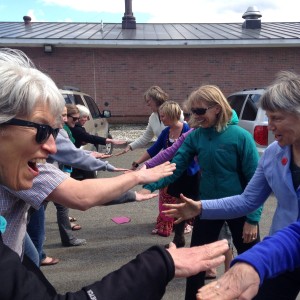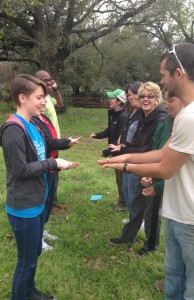May 09, 2014 A Tag Game That is So Much More: Practicing Collaboration, Consensus and Decision-Making Through Play
 This time of year I find myself facilitating a number of student team-building programs, “step up” days where students visit their new school and new classmates for the first time, field days, and camp trainings. The advisory leaders I work with often ask for activities that they can use for bringing their students outside for a session to focus on group building and social-emotional skills development. These are perfect opportunities to use active tag games that exemplify “play with a purpose.” One of my favorites is Rock Paper Scissors Tag.
This time of year I find myself facilitating a number of student team-building programs, “step up” days where students visit their new school and new classmates for the first time, field days, and camp trainings. The advisory leaders I work with often ask for activities that they can use for bringing their students outside for a session to focus on group building and social-emotional skills development. These are perfect opportunities to use active tag games that exemplify “play with a purpose.” One of my favorites is Rock Paper Scissors Tag.
Rock Paper Scissors Tag
This tried and true variation of the playground decision-making tool Rock, Paper, Scissors was put forward by the New Games Foundation in the 1970’s. It has become a favorite of mine because reinforces a method youth still use on the playground to practice consensus, so it really seems to hit home when we play it with a purpose. This game can be adapted for small classroom spaces by adding a rule that players must move in a heel-to-toe walk, which slows everyone down to an appropriate speed for a small space.
Facilitation Suggestions:
- Divide the group into two teams.(See previous post for partner compromise activity).
- Explain Rock Paper Scissors to the group. Most participants are familiar with Rock Paper Scissors as way to make decisions and resolve conflict in social and play situations without calling in a mediator. Rock beats scissors. Scissors cuts paper. Paper covers rock.
- Use poly spots or other markers to set up boundaries. Delineate a middle “face-off” line and two lines on either end of the playing area that represent each team’s “safe” area.
- Instruct each team to form a huddle in their safe area and decide as a team whether they are going to be rock, paper, or scissors. Emphasize that they can only be one of these things (i.e., the whole team has to agree on choosing the same sign). This is where the lesson on leadership conflict resolution and compromise comes in as some groups struggle with working together to agree on a sign.
- Sometimes I have team members come up with an alternate choice in case there is a tie and we want to do a second tie breaking round.
- After both teams have come to a decision, have them come to the middle face-off area.
- On the count of three, have teams show their signs. The winning team chases the opposing team.
- If a participant is tagged before reaching the safe area; she is captured and joins the tagging team.
Facilitation Notes:
People of all ages get caught up in the fun and excitement of this game and will usually eagerly partcipate in a number of rounds. Sometimes groups will use strategy, luck, or some kind of consensus to end the game. Each group’s approach is different and can lead to interesting reflection discussions on decision-making, group communication, and consensus.
 Outcomes/Reflection:
Outcomes/Reflection:
In a high school challenge course class, we used Rock Paper Scissors Tag as a warm up during our first week. When read student’s journal statements that week, we were surprised by their intense reactions to what my co-teacher and I thought was purely a fun “ice-breaking” game. Students journaled more about the dynamics of group decision-making, communication, working with students from different grades and cliques, and challenges in coming to group consensus on the rock paper sign that they did about the climbing wall and other activities we thought were more emotionally charged.
That same week, I used Rock, Paper, Scissors Tag with 4th and 5th graders as a communication builder and warm-up to another problem-solving activity I had planned. One of the teams repeatedly came to the middle with all three signs. Clearly they had not agreed on a group strategy. I stopped the action and asked the group what was happening. This led to an in-depth discussion by the students around decision-making and leadership, and the difference between a democracy and a dictatorship (topics they were studying in social studies). They also tied this experience to a recent school election and how they wanted decisions made in their classroom. As evidenced by this discussion, this activity became much more than just an icebreaker!
Reference: There are many variations of this game. I was first introduced to this activity through The New Games Foundation who credits John O’Connell as the creator (Fleugelman, 1976). In their second book it evolved to Giants, Wizards and Elves (New Games Foundation, 1981).



No Comments